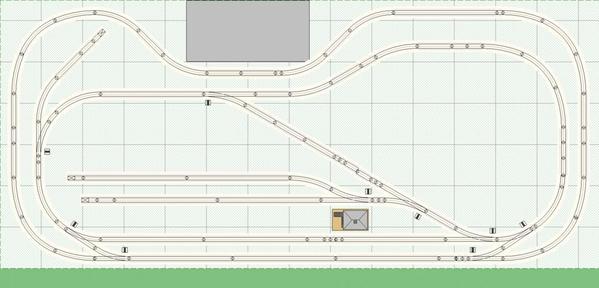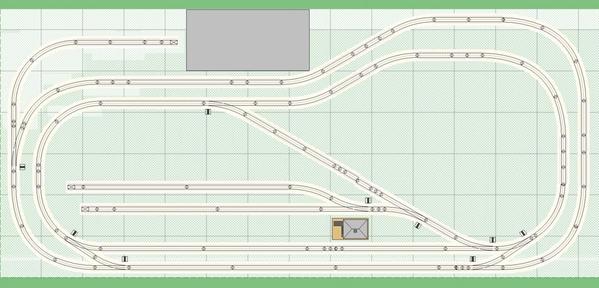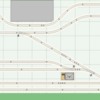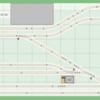You asked for an opinion...be careful what you ask for! :-)
Please receive this in the positive spirit that it’s intended to be. I hope to provide you with much “food for thought” for your future layout:
Many more numerous times than I can recall, for the past too many years, people have requested assistance in planning a layout. Time after time, track arrangements are immediately shown and discussed. Track arrangement is NOT planning a layout. Obviously it is an important part.
Far too many times, regardless of scale, model railroaders end up with a collection of railroad engines and rolling stock from all over the place that circle and circle a loop(s) of track. In the end, what do they have?
There are three main types of layouts: Toy train layouts, Display layouts and Operational layouts.
A toy train layout doesn’t follow scale considerations and its purpose is to enjoy many trains and accessories and has a rainbow of railroads, actual and imaginary, not adhering to prototypical (actual) railroad modeling. These layouts are almost always loops of track going pretty much nowhere all of the time. This would include “starter sets.”
A display layout is to show trains. This layout may be a hybrid of toy train and operational model railroad layout or some combination thereof. These layouts often contain multiple circles of tracks, with the tracks having no logical route, and allow the trains to be run with minimal human intervention. A club modular layout would be an example.
An operational layout is set-up in a prototypical manner whereby the trains go from one point to another where they may drop off or pick up rolling stock simulating the actions and operation of a real railroad. Typically, a specific railroad (or two) is selected and an operational theme is selected and followed. The track arrangement is patterned after real life as well; meaning no circles or loops of track.
Again, without intending to upset anyone’s sensitivities, far too many model railroaders end up with a hodge-podge miss-mesh collection of railroad and rolling stock from the beginning of time to the modern day. Their layouts aren’t very good as it is an illogical collection of unrelated items and time periods placed together.
You cannot let someone else tell you how to “plan” your layout unless you provide them with a multitude of details. How can you or anyone else start to track “plan” when you or they don’t know what your railroad is supposed to be, where it is, what it is doing, etc.?
If you actually want to build a great model of a railroad, not just circle without rhyme or reason, you must first decide what it is you want and what you want your layout to look like when it’s completed.
People that haphazardly throw track arrangements together, via trial and error, will be disappointed in the end as they keep changing the arrangement over and over again seeking the perfect track plan that they will never find.
If you want to create a model of a railroad you must first decide: What railroad(s) am I modeling? What is my railroad doing? (Freight, Passengers, Both or Other?) Where is my railroad located and what other (if any) railroads is my line connected to? When: period of time am I modeling? How will I research and gather all of the information required to construct a successful model of a railroad?
ALL truly great model railroads contain three essential elements: Plausibility, Purpose and Participation. Plausibility—is the design of the layout is believable even if it is entirely made up (free-lanced). Purpose, ALL railroads have a purpose. Your model of a railroad should have a purpose, a reason for being, how does it earn money to continue operating? Finally, Participation! This is where the fun comes in! What will you or others at your railroad be doing? If everyone is standing there simply watching the trains circle the same track with the same consist never changing direction and seemingly going nowhere the fun won’t last long.
You, and others, need something to do. The more you have to do, the more interaction is offered, the more enjoyment you will experience! It is fun, entertaining and enjoyable to become part of a railroad crew.
BEFORE any track arranging can commence, you need to know the who, what, where, when, why and how of your layout. The track arrangement for a switching operation is different from a main-line run. A mountain route is different from a run along a seashore or prairie.
If you are striving to create a model of a railroad attempt to get your trains going somewhere, not just circling. I understand that people have limited space. I did for years on end. If your space is limited, plan a nice switching layout or small branch-line scene, maybe a logging operation? There are numerous possibilities.
If your space is limited, and you feel you must circle, use temporary on the floor track and circle to your heart’s delight! When spending money to construct a layout surface and add scenery plan something nice for yourself and others. Some spectacular layouts were/are 8 feet long and 18 inches wide. It doesn’t have to circle or loop!
Most importantly, plan a point to point scheme. Get the trains going somewhere. Add return loops/reversing loops at both “ends” of your line so that a train may travel to the next town and then be turned around and return. Have a siding at or near the ends of your line.
Give your line a purpose. You (or others) control the train. Stop at the sidings. Drop off and pick-up. This will provide you participation and engage you in the activity. I encourage and challenge you to stop running circles and loops.
This is the irony of model railroading: real trains go from point to point and include much straighter track than curves. In the model world, the vast majority of trains circle or loop, and there are far more curves.
I do appreciate that there are instances such as modular clubs that this wouldn’t apply. I’m merely trying to help and suggesting to others to attempt to create a better design for a layout that will provide them with years of enjoyment. Get involved with your trains! Give yourself a part in the operations of your layout. Get others involved!
Have fun! But seriously consider the challenges and fun of modeling a railroad!
My two cents.









